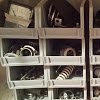Sideway uses lean angle to control speed, and a wireless Nunchuk controller to steer. There are two 280W, 24V electric scooter motors, one on each wheel, driven by a Sabertooth 2x32A motor controller. The batteries are 3 cell, 5 Ah lithium polymer, normally used for model aircraft. It'll go about 40 minutes or so on a charge, depending on what you're doing.
I'm running a Parallax Propeller with custom software for the IMU and control.
It gets a good amount of attention. :)
I have the next version planned, and all the parts are here, I just need the time to work on it. It'll have a wider wheelbase, belt drive instead of chains, and a shorter board. I may also use a proper skateboard or longboard deck and put some grip tape on it.
Hanging out at the local craft store:
It'll go about 10 miles per hour (this clip is probably close to that):
 Jason Dorie
Jason Dorie




Thanks for posting Jason. Can you tell me where you bought your big belt pulley? Would you mind adding the belt and pulleys to the components list or telling me the specs?